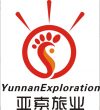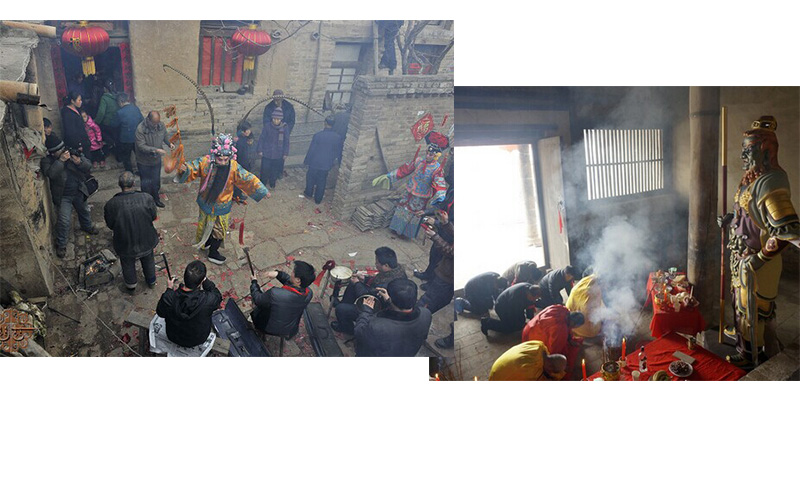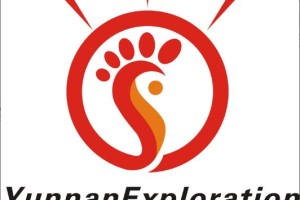
March Fair or Dragon King Temple Fair of Naxi Ethnic Minority in Lijiang
Geographical Location
The Naxi Dragon King Temple Fair (纳西族龙王庙会) is usually held by the Black Dragon Pool (黑龙潭) in Lijiang County, Yunnan Province (云南丽江县城), within the present-day “Yuquan Park” (玉泉公园). Lijiang (丽江) is located in the northwestern part of Yunnan Province (云南省西北部), on the southeastern edge of the Tibetan Plateau (青藏高原东南缘), in the Yunnan-Northwest Plateau (滇西北高原), and in the middle reaches of the Jinsha River (金沙江中游). It is bordered by the Diqing Tibetan Autonomous Prefecture (迪庆藏族自治州) to the north, the Dali Bai Autonomous Prefecture (大理白族自治州) to the south, the Nujiang Lisu Autonomous Prefecture (怒江傈僳族自治州) to the west, and it is adjacent to the Liangshan Yi Autonomous Prefecture (四川凉山彝族自治州) and Panzhihua City (攀枝花市) of Sichuan Province to the east. With its superior geographical location and convenient transportation, Lijiang (丽江) is surrounded by magnificent natural landscapes. The majestic Jade Dragon Snow Mountain (玉龙雪山) stands tall, and the Jinsha River (金沙江) winds through the area, adding a unique regional charm to the temple fair. Inside Yuquan Park (玉泉公园), ancient trees tower over the land, the pond water is crystal clear, and pavilions and towers are scattered in an orderly fashion, creating a unique scene that contrasts with the bustling temple fair.


History and Culture
The Naxi Dragon King Temple Fair (纳西族龙王庙会) has a long history and is closely related to the Naxi people’s worship of nature and their belief in the Dragon King (龙王). In Naxi traditional culture, the Dragon King (龙王) is believed to control water sources, which are vital for agricultural irrigation and daily life. According to legends, the Dragon King (龙王) can summon wind and rain and protect the local area from harm. Therefore, around the 15th day of the third lunar month every year, Naxi people gather together to hold a grand temple fair to worship the Dragon King (龙王) and pray for favorable weather and a bountiful harvest. Over time, the temple fair has evolved into a gathering for material exchange among various ethnic groups. It is not only a way for the Naxi people to express their awe and gratitude towards nature but also promotes economic and cultural exchanges between different ethnic groups. During the fair, ancient legends are passed down orally among the crowd, continuing the ancestors’ respect for nature and their aspiration for a better life.
Folklore and Features
Sacrificial Ceremony
During the temple fair, the sacrificial ceremony is solemn and sacred. Naxi men and women, dressed in their colorful traditional costumes, hold flowers and offerings and march towards the sacrificial site in整齐的步伐. The exquisite embroidery patterns on their costumes, such as sun, moon, stars, flowers, birds, fish, and insects, contain the cultural connotations and good wishes of the Naxi people. The chief priest places the offerings on the altar, lights the incense and candles, and worships the Dragon King (龙王) devoutly, murmuring prayers for protection. The crowd then takes turns to offer incense, expressing their respect for the Dragon King (龙王) and their hopes for the future. The entire sacrificial process is full of ritual, reflecting the Naxi people’s adherence to traditional culture.
Folk Performances
Dongba Dance (东巴舞)
As a traditional Naxi dance, Dongba Dance (东巴舞) is wonderfully performed at the temple fair. The dancers have agile postures and movements that combine strength and grace. They hold ritual instruments and dance in rhythm with unique drumbeats and music. The dance movements imitate various aspects of nature, such as birds soaring, horses galloping, and trees swaying, reflecting the Naxi people’s concept of harmonious coexistence with nature. Dongba Dance (东巴舞) is not only entertaining but also a form of religious expression, carrying forward the ancient beliefs of the Naxi people.
Naxi Ancient Music (纳西古乐)
The melodious and mysterious performance of Naxi Ancient Music (纳西古乐) is a highlight of the temple fair. Band members, dressed in traditional costumes, play ancient instruments such as Sigu Duto (苏古笃), curved-neck pipa (曲项琵琶), and Naxi huqin (纳西胡琴). The repertoire includes both the Dongjing music originating from Central Plains and local Naxi folk tunes. The music has an ancient and elegant melody with a long-lasting charm, as if it could penetrate time and space, allowing people to experience the allure of the ancient Naxi civilization. During the performance, the audience is immersed in the music, enjoying this unique artistic experience.
Specialties
Roasted Rushan (烤乳扇)
Roasted Rushan (烤乳扇) is a Naxi specialty snack that can be found everywhere at the temple fair. The Rushan is grilled over charcoal fire until it expands and changes color, then brushed with rose syrup or white sugar, emitting a fragrant aroma. The roasted Rushan has a crispy texture, is sweet but not greasy, and combines the rich flavor of dairy products with the sweetness of rose syrup, leaving a lasting impression.
Lijiang Baba (丽江粑粑)
Lijiang Baba (丽江粑粑) comes in sweet and savory flavors. The sweet Baba is filled with rose syrup, red bean paste, etc., with a crispy outer skin and sweet inner filling; the savory Baba includes ingredients like scallions and ham, with a salty and fragrant taste. Made from high-quality local wheat flour, Lijiang Baba (丽江粑粑) goes through several processes, including kneading, resting, rolling, and filling, before being pan-fried. Its golden color and enticing aroma make it one of the favorite foods of tourists during the temple fair.
Weather and Best Time to Visit
Weather Conditions
Lijiang (丽江) has a low-latitude warm temperate plateau monsoon climate (低纬暖温带高原山地季风气候). In March, it is spring, and the weather is gradually warming up, with an average temperature between 10℃ and 20℃, making it quite comfortable. However, the weather in Lijiang (丽江) is changeable, and there is a significant temperature difference between day and night, so it is necessary to keep warm when going out in the morning and evening. At this time, there is relatively less precipitation, and it is mostly sunny with bright sunshine, suitable for outdoor activities. However, the weather in the mountainous areas can change quickly, and occasional showers may occur, so it is advisable to bring an umbrella just in case.
Best Time to Visit
The temple fair usually lasts for about a week. The days around the 15th day of the third lunar month are the climax of the fair, when activities are the most abundant and the atmosphere is the liveliest. This is the best time to visit. During this period, you can witness the complete sacrificial ceremony, enjoy wonderful folk performances, taste various specialties, and participate in material exchange activities, fully experiencing the charm of the temple fair. If you have more time, you can also arrive in Lijiang (丽江) a few days before or after the fair to visit surrounding attractions and get a feel for the local customs and traditions.
Sightseeing Recommendations
Black Dragon Pool Park (黑龙潭公园)
As the venue for the temple fair, Black Dragon Pool Park (黑龙潭公园) has beautiful scenery. The pond water is crystal clear, reflecting the majestic figure of Jade Dragon Snow Mountain (玉龙雪山), creating the beautiful scene of “snow mountain reflected in the pond.” Ancient trees tower over the pond, and pavilions and towers are scattered in an orderly fashion. Strolling along the paths in the park, you can admire various flowers and plants, with different scenery in each season. During the temple fair, the park is filled with stalls, a wide variety of goods, and a bustling crowd. In addition to participating in the fair activities, you can also take photos in the park to create lasting memories.
Lijiang Ancient Town (丽江古城)
Not far from Black Dragon Pool Park (黑龙潭公园) is the Lijiang Ancient Town (丽江古城), a World Cultural Heritage site (世界文化遗产) with unique Naxi architectural style. The streets in the ancient town are built along the mountains and rivers, paved with red conglomerate, and the houses are mostly made of earth and wood, combining the characteristics of Central Plains architecture and Naxi architecture. Walking through the alleys of the ancient town, you can feel the strong ethnic atmosphere. There are various specialty shops along the streets, selling ethnic handicrafts, clothing, and food. At night, the ancient town is brightly lit, with bustling bars and restaurants, forming a stark contrast to the quiet and simple daytime.
Jade Dragon Snow Mountain (玉龙雪山)
Jade Dragon Snow Mountain (玉龙雪山) is the sacred mountain of the Naxi people and a symbolic scenic spot in Lijiang (丽江). It consists of 13 continuous peaks, resembling a giant dragon soaring and dancing, hence the name. The snow on the mountain never melts throughout the year, and under the sunlight, it shines with a silvery light, creating a magnificent view. Visitors can take a cable car to climb the mountain and enjoy the alpine meadows, primeval forests, glaciers, and other landscapes. At the foot of the mountain, there are also attractions such as Blue Moon Valley (蓝月谷) and Ganhaizi (甘海子). The water in Blue Moon Valley (蓝月谷) is as blue as a gemstone, and under the sunlight, it displays a dreamlike color.
Transportation Guide
External Transportation (外部交通)
By air: Lijiang Sanyi International Airport (丽江三义国际机场) is the main air gateway to Lijiang (丽江), with direct flights to many cities in China, such as Beijing (北京), Shanghai (上海), Guangzhou (广州), Shenzhen (深圳), Chengdu (成都), Kunming (昆明), etc. From the airport to Lijiang city center, you can take the airport shuttle bus, which has several routes available, with fares generally ranging from 20 to 30 yuan. You can also take a taxi, which costs about 80 to 100 yuan.
By train: Lijiang Station (丽江站) has trains to and from Kunming (昆明), Dali (大理), and other places. The train journey from Kunming (昆明) to Lijiang (丽江) takes about 4 to 5 hours. After arriving at Lijiang Station (丽江站), you can take a bus to the city center. There are several bus routes available, with fares generally at 1 to 2 yuan. You can also take a taxi, which costs about 30 to 50 yuan to the city center.
In-City Transportation
By bus: Lijiang’s (丽江) bus network is well-developed, and you can take a bus to Black Dragon Pool Park (黑龙潭公园). You can check the specific bus routes through mobile map navigation apps. The bus fare is generally 1 to 2 yuan. However, during the temple fair, buses may be crowded due to the large number of people.
By taxi/ride-hailing car: Taking a taxi or ride-hailing car is a convenient option for traveling within the city. The starting fare for a taxi is generally 8 to 10 yuan, with subsequent charges based on distance and time. During the temple fair, it may be necessary to wait in line for a taxi due to the high volume of people, so it is recommended to book a ride-hailing car in advance.
By bike/e-bike: If you have a short journey and prefer the freedom to travel at your own pace, bicycles and e-bikes are good choices. There are many bike and e-bike rental points in Lijiang city center, which are easy to use and reasonably priced. However, please pay attention to traffic safety and follow traffic rules while riding.
Food Recommendations
In addition to Roasted Rushan (烤乳扇) and Lijiang Baba (丽江粑粑) at the temple fair, there are many other delicious foods in Lijiang (丽江) worth trying.
Smoked Pork Rib Hot Pot (腊排骨火锅)
Selected from high-quality pork ribs, which are marinated and then dried, and stewed with local ingredients such as potatoes, corms, and carrots. The savory flavor of the smoked ribs combines with the sweetness of the vegetables, creating a rich soup and tender meat. It is a signature dish in Lijiang (丽江) and can be tasted in many restaurants in the city center.
Naxi Grilled Fish (纳西烤鱼)
Using fresh fish as the main ingredient, the fish is first grilled until the skin is golden and crispy, then special sauce and various ingredients such as tofu, konjac, and bean sprouts are added and stewed in an iron pan. The grilled fish is crispy on the outside and tender on the inside, with the aroma of the sauce fully penetrating the fish meat. It has a spicy and fresh taste that is unforgettable.
Chicken Bean Jelly (鸡豆凉粉)
Chicken Bean Jelly (鸡豆凉粉) is one of the special snacks in Lijiang (丽江), made from chicken beans. The jelly is black and has a smooth texture. It can be served cold with soy sauce, vinegar, chili oil, Sichuan pepper oil, and garlic paste, giving it a sour and spicy taste. It can also be pan-fried. The fried jelly has a crispy skin and soft interior, and when eaten with chili powder, it has a unique flavor.
Shopping Recommendations
Dongba Paper Products (东巴纸制品)
Dongba paper (东巴纸) is a traditional handmade paper of the Naxi people, made from the bark of the Daphne plant using ancient techniques. The paper is strong, resistant to insect damage, and can be preserved for a long time. It usually has Dongba characters or patterns printed on it, which have high artistic and collection value. In the specialty shops of Lijiang Ancient Town (丽江古城), you can buy notebooks, bookmarks, postcards, and other items made from Dongba paper.
Naxi Embroidery Crafts (纳西刺绣工艺品)
Naxi embroidery has a long history, with delicate stitches and bright colors. The embroidery themes are extensive, including flowers, birds, figures, and landscapes. You can purchase embroidered handkerchiefs, bags, and accessories, which are not only beautiful but also practical, and allow you to appreciate the exquisite embroidery skills of the Naxi people.
Wood Carving Crafts (木雕工艺品)
Lijiang’s (丽江) wood carving craftsmanship is exquisite. High-quality wood is selected to carve various lifelike patterns and shapes. There are many types of wood carving crafts, including pendants, ornaments, and furniture. Whether for personal collection or as gifts for relatives and friends, they are excellent choices. You can find your favorite wood carving works in the city’s wood carving shops.
Accommodation Suggestions
Lijiang Ancient Town Inns
There are many inns in Lijiang Ancient Town (丽江古城), most of which retain the traditional architectural style of the Naxi people, with interiors decorated in ethnic style. Staying in an ancient town inn allows you to conveniently experience the charm of the ancient town and the life atmosphere of the Naxi people. However, during the temple fair, the inns in the ancient town are very popular, so it is recommended to book in advance. The prices vary according to the class and location of the inn, generally ranging from 200 to 1000 yuan.
City Hotels
If you prefer modern accommodation facilities and convenient transportation, you can choose a hotel in the city center. There are hotels of various classes in the city, from budget hotels to high-end star hotels. City hotels are close to Black Dragon Pool Park (黑龙潭公园) and the temple fair venue, making it easy to travel. The prices are relatively lower than those of the ancient town inns. Economic-type hotels cost about 100 to 300 yuan, while star hotels cost about 500 to 1500 yuan.
Unique Bed and Breakfasts
In addition to ancient town inns and city hotels, Lijiang (丽江) also has many unique bed and breakfasts. For example, the ones located in Shuhe Ancient Town (束河古镇) have a quiet environment and a strong artistic atmosphere. Those at the foot of Jade Dragon Snow Mountain (玉龙雪山) allow you to enjoy the beautiful snow mountain scenery up close. These bed and breakfasts usually provide personalized services, with cozy and comfortable rooms. They are also good choices during the temple fair, but booking in advance is recommended. The prices vary according to the characteristics and locations of the bed and breakfasts, generally ranging from 300 to 1500 yuan.

 7 Days GolfingTour
7 Days GolfingTour
 8 Days Group Tour
8 Days Group Tour
 8 Days Yunnan Tour
8 Days Yunnan Tour
 7 Days Shangri La Hiking
7 Days Shangri La Hiking
 11 Days Yunnan Tour
11 Days Yunnan Tour
 6 Days Yuanyang Terraces
6 Days Yuanyang Terraces
 11 Days Yunnan Tour
11 Days Yunnan Tour
 8 Days South Yunnan
8 Days South Yunnan
 7 Days Tea Tour
7 Days Tea Tour
 8 Days Muslim Tour
8 Days Muslim Tour
 12 Days Self-Driving
12 Days Self-Driving
 4 Days Haba Climbing
4 Days Haba Climbing
 Tiger Leaping Gorge
Tiger Leaping Gorge
 Stone Forest
Stone Forest
 Yunnan-Tibet
Yunnan-Tibet
 Hani Rice Terraces
Hani Rice Terraces
 Kunming
Kunming
 Lijiang
Lijiang
 Shangri-la
Shangri-la
 Dali
Dali
 XishuangBanna
XishuangBanna
 Honghe
Honghe
 Kunming
Kunming
 Lijiang
Lijiang
 Shangri-la
Shangri-la
 Yuanyang Rice Terraces
Yuanyang Rice Terraces
 Nujiang
Nujiang
 XishuangBanna
XishuangBanna
 Spring City Golf
Spring City Golf
 Snow Mountain Golf
Snow Mountain Golf
 Stone Mountain Golf
Stone Mountain Golf



